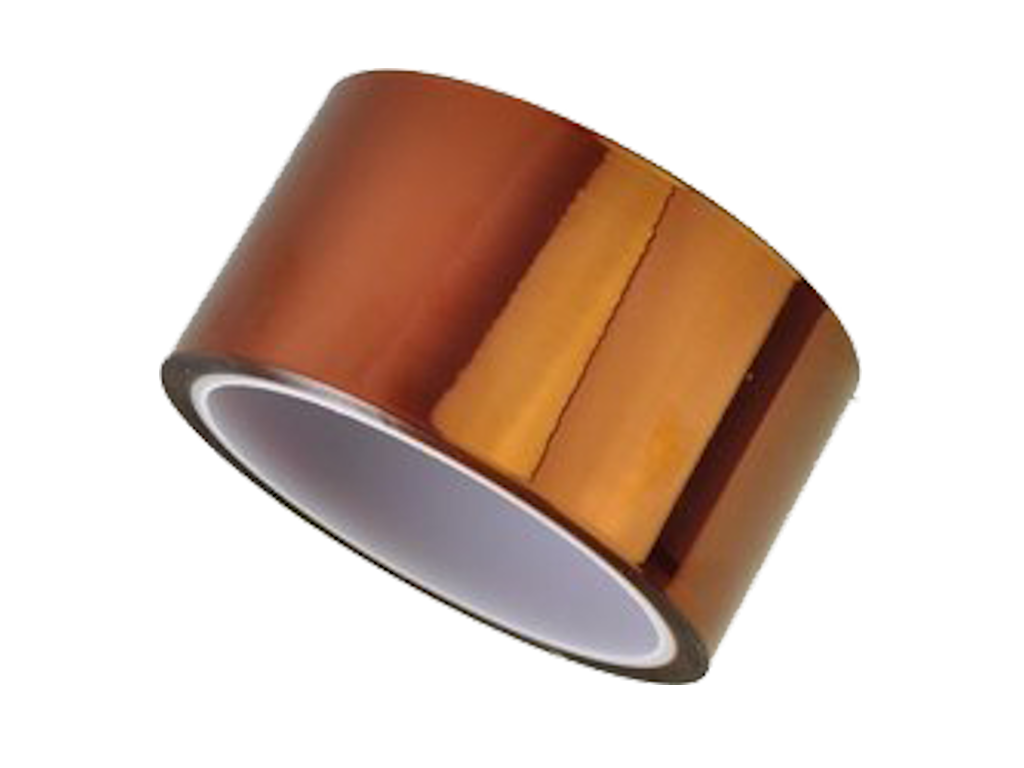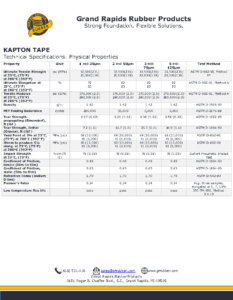KAPTON TAPE
Kapton tape, developed by DuPont, is a polymide general purpose film with silicone adhesive. It shows excellent dielectric qualities, superior resistance in the face of extreme temperatures, and excellent solvent resistance.
Kapton is regularly used as an insulator in ultra-high vacuum environments due to its low outgassing rate, which makes it ideal for aeronautical, and space applications. Due to its large range of temperature stability, and its electrical isolation ability, Kapton tape is usually used in electronic manufacturing as an insulation and protection layer on electrostatic sensitive and fragile components.

FEATURES

KAPTON TAPE
Technical Data
Product Specs
Physical Properties of Kapton Tape at 73°F (23°C )
| Property | Unit | 1 mil 25μm | 2 mil 50μm | 3 mil 75μm | 5 mil 125μm | Test Method |
|---|---|---|---|---|---|---|
| Ultimate Tensile Strength | psi (MPa) | |||||
| at 23°C, (73°F) | 33,500(231) | 33,500(231) | 33,500(231) | 33,500(231) | ASTM D-882-91, Method A* | |
| at 200°C (392°F) | 20,000(139) | 20,000(139) | 20,000(139) | 20,000(139) | ||
| Ultimate Elongation | % | |||||
| at 23°C, (73°F) | 72 | 82 | 82 | 82 | ASTM D-882-91, Method A | |
| at 200°C (392°F) | 83 | 83 | 83 | 83 | ||
| Tensile Modulus at 23°C, (73°F) | psi (GPa) | |||||
| at 23°C, (73°F) | 370,000 (2.5) | 370,000 (2.5) | 370,000 (2.5) | 370,000 (2.5) | ASTM D-882-91, Method A | |
| at 200°C (392°F) | 290,000 (2.0) | 290,000 (2.0) | 290,000 (2.0) | 290,000 (2.0) | ||
| Density | g/cc | 1.42 | 1.42 | 1.42 | 1.42 | ASTM D-1505-90 |
| MIT Folding Endurance | cycles | 285000 | 55000 | 6000 | 5000 | ASTM D-2176-89 |
| Tear Strength-propagating (Elmendorf) | N (lbf ) | 0.07 (0.02) | 0.21 (0.02) | 0.38 (0.02) | 0.58 (0.02) | ASTM D-1922-89 |
| Tear Strength, Initial (Graves) | N (lbf ) | 7.2 (1.6) | 16.3 (1.6) | 26.3 (1.6) | 46.9 (1.6) | ASTM D-1004-90 |
| Yield Point at 3% | MPa (psi) | |||||
| at 23°C, (73°F) | 69 (10,000) | 69 (10,000) | 69 (10,000) | 69 (10,000) | ASTM D-882-91 | |
| at 200°C (392°F) | 41 (6,000) | 41 (6,000) | 41 (6,000) | 41 (6,000) | ||
| Stress to produce 5% | MPa (psi) | |||||
| at 23°C, (73°F) | 90 (13,000) | 90 (13,000) | 90 (13,000) | 90 (13,000) | ASTM D-882-92 | |
| at 200°C (392°F) | 61 (9,000) | 61 (9,000) | 61 (9,000) | 61 (9,000) | ||
| Impact Strength at 23°C, (73°F) | N·cm·(ft lb) | 78 (0.58) | 78 (0.58) | 78 (0.58) | 78 (0.58) | DuPont Pneumatic Impact Test |
| Coefficient of Friction, kinetic (film-to-film) | 0.48 | 0.48 | 0.48 | 0.48 | ASTM D-1894-90 | |
| Coefficient of Friction, static (film-to-film) | 0.63 | 0.63 | 0.63 | 0.63 | ASTM D-1894-90 | |
| Refractive Index (sodium D line) | 1.7 | 1.7 | 1.7 | 1.7 | ASTM D-542-90 | |
| Poisson’s Ratio | 0.34 | 0.34 | 0.34 | 0.34 | Avg. three samples, elongated at 5, 7, 10% | |
| Low temperature flex life | pass | pass | pass | pass | IPC-TM-650, Method 2.6.18 | |
| *Specimen size 25 x 150 mm (1.6 in); jaw separation 100 mm (4 in), jaw speed, 50mm/min (2 in/min). Ultimate refers to the tensile strength and elongation measured at break. | ||||||
Thermal Properties of DuPont™ Kapton® HN Film
| Thermal Property | Typical Value | Test Condition | Test Method |
|---|---|---|---|
| Melting Point | None | None | ASTM E-794-85 (1989) |
| Thermal Coefficient of Linear Expansion | 20 ppm/°C | -14 to 38°C | ASTM D-696-91 |
| (11 ppm/°F) | (7 to 100°F) | ||
| Coefficient of Thermal Conductivity, W/m·K | 0.12 | 296K | ASTM F-433-77 (1987) |
| cal cm·sec·°C | 2.87 x 104 | 23°C | |
| Specific Heat, J/g•K (cal/g·°C) | 1.09 (0.261) | Differential calorimetry | |
| Heat Sealability | not heat sealable | ||
| Solder Float | pass | IPC-TM-650 Method 2.4.13A | |
| Smoke Generation | Dm=<1 | NBS smoke chamber | NFPA-258 |
| Shrinkage, % | 0.17 | IPC-TM-650 Method 2.2.4A; ASTM D-5214-91 | |
| 30 min at 150°C 120 min at 400°C | 1.25 | ||
| Limiting Oxygen Index, % | 37–45 | ASTM D-2863-87 | |
| Glass Transition Temperature (Tg) | A second order transition occurs in Kapton® between 360°C (680°F) and 410°C (770°F) and is assumed to be the glass transition temperature. Different measurement techniques produce different results within the above temperature range. | ||
Typical Electrical Properties of DuPont™ Kapton® HN Film at 23°C (73°F), 50% RH
| Property Film Gage | Typical Value | Test Condition | Test Method |
|---|---|---|---|
| Dielectric Strength | V/m kV/mm | ||
| 25 μm (1 mil) | 303 | 60 Hz 1/4 in electrodes 500 V/sec rise | ASTM D-149-91 |
| 50 μm (2 mil) | 240 | ||
| 75 μm (3 mil) | 205 | ||
| 125 μm (5 mil) | 154 | ||
| Dielectric Constant | |||
| 25 μm (1 mil) | 3.4 | 1 kHz | ASTM D-150-92 |
| 50 μm (2 mil) | 3.4 | ||
| 75 μm (3 mil) | 3.5 | ||
| 125 μm (5 mil) | 3.5 | ||
| Dissipation Factor | |||
| 25 μm (1 mil) | 0.0018 | 1 kHz | ASTM D-150-92 |
| 50 μm (2 mil) | 0.002 | ||
| 75 μm (3 mil) | 0.002 | ||
| 125 μm (5 mil) | 0.0026 | ||
| Volume Resistivity | |||
| 25 μm (1 mil) | cm 1.5 x 1017 | ASTM D-257-91 | |
| 50 μm (2 mil) | cm 1.5 x 1017 | ||
| 75 μm (3 mil) | cm 1.4 x 1017 | ||
| 125 μm (5 mil) | cm 1.0 x 1017 | ||
| Temperature Range, °C, (°F) | ppm/°C |
|---|---|
| 30–100 (86–212) | 17 |
| 100–200 (212–392) | 32 |
| 200–300 (392–572) | 40 |
| 300–400 (572–752) | 44 |
| 30–400 (86–752) | 34 |
